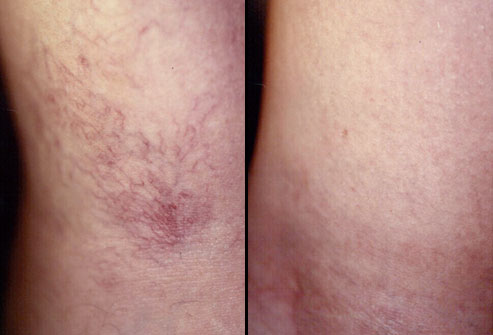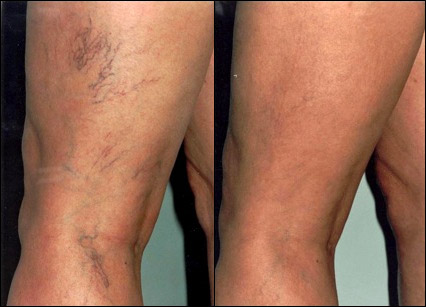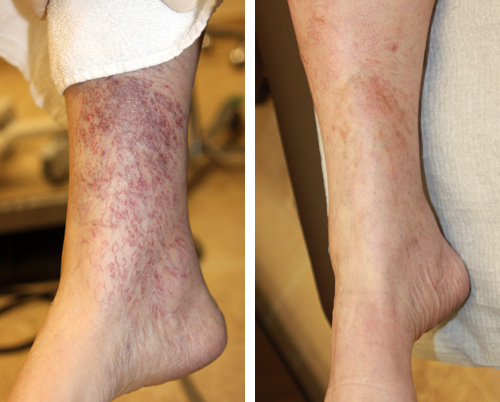Spider veins, also known as thread veins or telangiectasia, are small dilated and visible superficial veins, measuring between 0.5 and 1 millimeter in diameter, that can occur near the surface of the skin causing red, blue or purple discolorations. Spider veins get their name from the shape of the discolorations. Thread veins are very common, affecting around 80% of adults, equally distributed between males and females and they are usually associated with underlying vein problems. These dilated blood vessels can develop anywhere on the body but are most common on the thighs, calves and ankles or face. When they occur on the legs, they often have underlying cause in form of venous reflux or hidden varicose veins.
Their cause isn’t completely understood in every case, but they can run in families. In some cases they are related to pregnancy, use of birth control pills or excessive weight.
Spider Veins – appearance and location

Symptoms and Diagnosis:
Red, blue or purple blood vessels appear, usually on the legs but sometimes on the face, chest or breast. Spider veins usually do not cause any symptoms, but may cause:
discomfort or aching
heaviness and tiredness
itchy and burning sensation
muscle cramps at night
Your vascular surgeon can diagnose spider veins during medical examination.
Spider veins on the legs which, being below the heart, become visible, contrary to face veins require venous duplex ultrasound scan study to identify abnormal venous flow before starting the treatment due to undiagnosed varicose veins hidden beneath the skin surface. Approximately 90% of women with spider veins in legs have underlying hidden varicose veins. About 40% of females with spider veins of the legs have severe underlying hidden varicose veins and 15% have incompetent perforators. With the above amount of gathered scientific evidence a specialist venous duplex ultrasound is always performed before attempting any kind of treatment. We have observed significant number of patients leg spider veins worsened due to not scanning before treatment. That’s why we always offer to perform a scan first.
Spider veins may be permanent or may disappear on their own after a period of months, especially if they are caused by pregnancy or certain medications.
Prevention:
Because the causes of spider veins aren’t completely understood, they can’t always be prevented. It’s helpful to maintain a healthy weight and stay physically fit.
If you have spider veins, you might help to avoid developing more of them by taking the following steps:
- Exercise regularly to improve your leg strength, promote circulation and vein tonus
- Manage your weight to avoid placing too much pressure on your legs
- Do not cross your legs when sitting and try to elevate your legs when resting or sleeping
- Wear support compression elastic stockings
- Avoid long periods of time of standing or sitting
The best possible treatment options:
The optimal management for leg spider veins include the following :
- Proper venous duplex ultrasound scan assessment performed by an experienced sonographer to rule out underlying hidden varicose veins
- Treatment of any underlying hidden varicose veins before planned treatment for the spider veins
- Treatment of spider veins at the same time or after procedure of underlying varicose veins. In many cases, treating the hidden varicose veins will get rid of the spider veins at the same time.

The two most commonly performed cosmetic procedures for spider veins are sclerotherapy and laser treatment:
• Sclerotherapy involves a sclerosant injection directly into the affected blood vessel, causing the veins to collapse and as a result fade away. The treated area may be tender for a few days and it may bruise and cause sometimes some discomfort or aching. Bruises usually fade spontaneously or after using topical gels over a few weeks. Depending on response to injections, sclerotherapy may require multiple sessions for the best cosmetic outcome.
• Laser treatment directs pulses from a laser light to the spider veins, causing tiny blood clots to form. The blood vessels become blocked off and eventually are reabsorbed by the body.
If you decide to treat your spider veins, you can expect a 50% to 90% improvement. You may need several treatment sessions to achieve the desired results. After treatment, a slight discoloration of the skin may remain for weeks or even as long as a year before fading. In many cases, spider veins disappear entirely, but they can return.
Patients who suffer from spider veins should seek the assistance of physicians who specialize in vein care or peripheral vascular disease.
Dr. Marek’s Sepiolo specializes in the treatment of all kind of spider veins of the legs as well as face, chest and breast.
BEFORE & AFTER
Spider Veins




